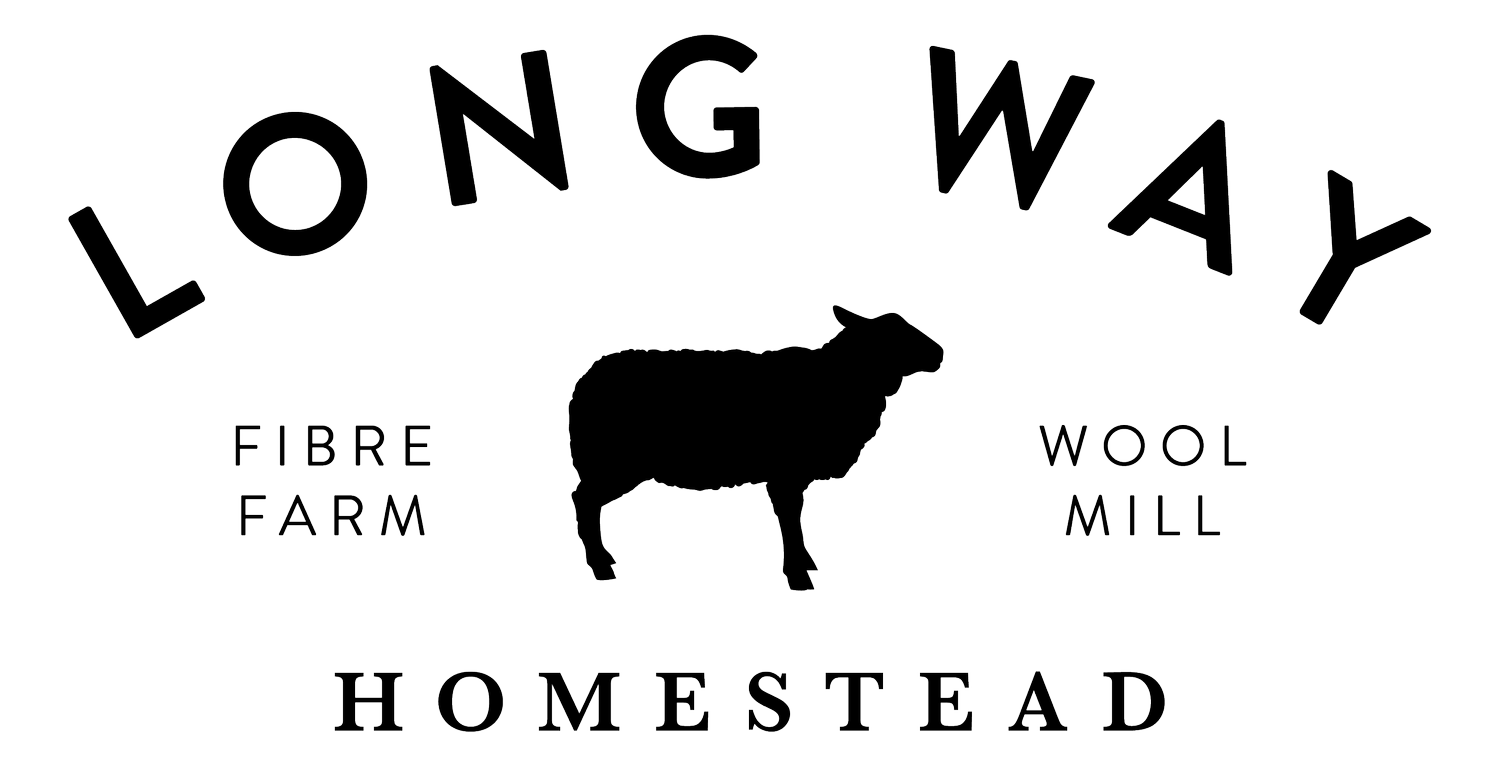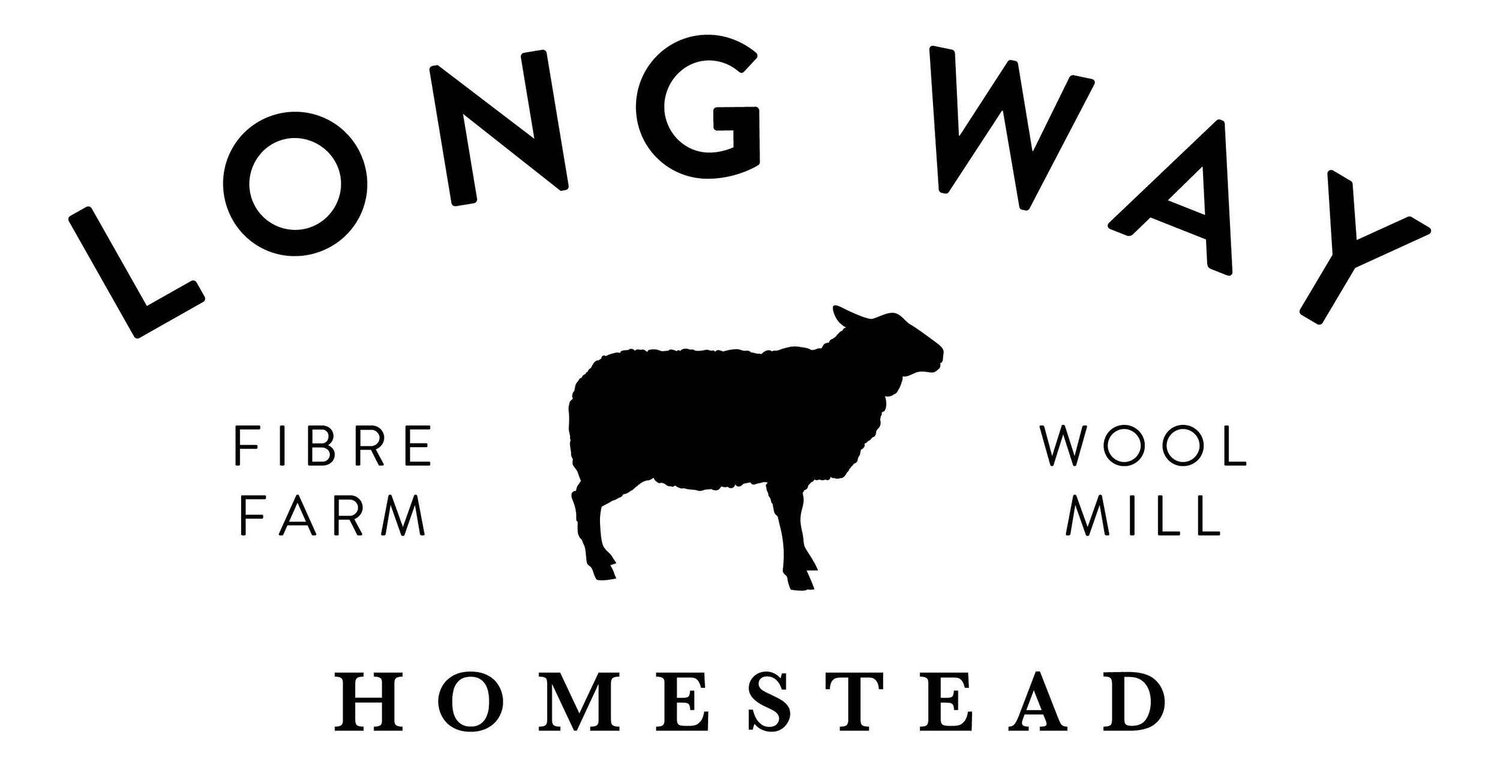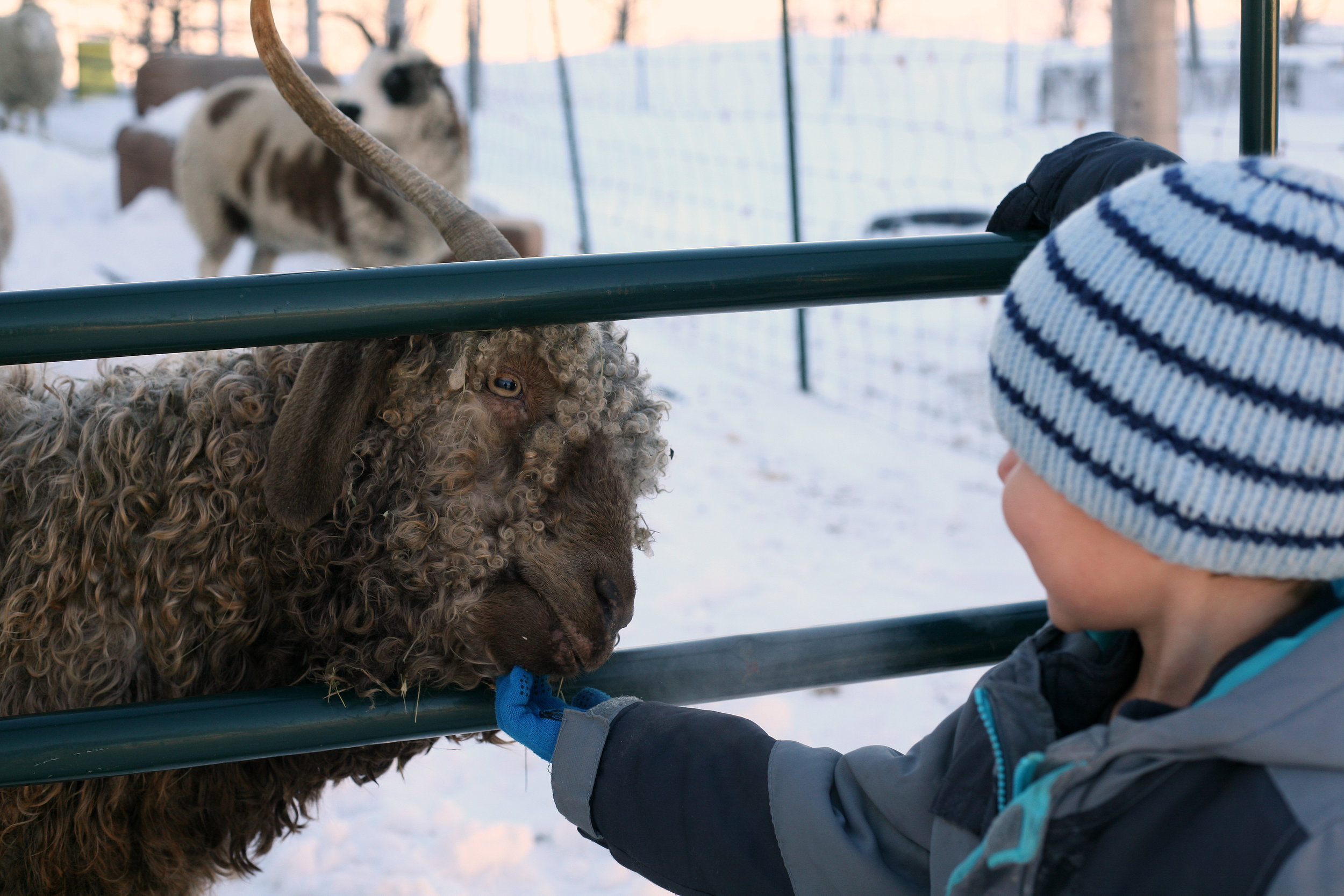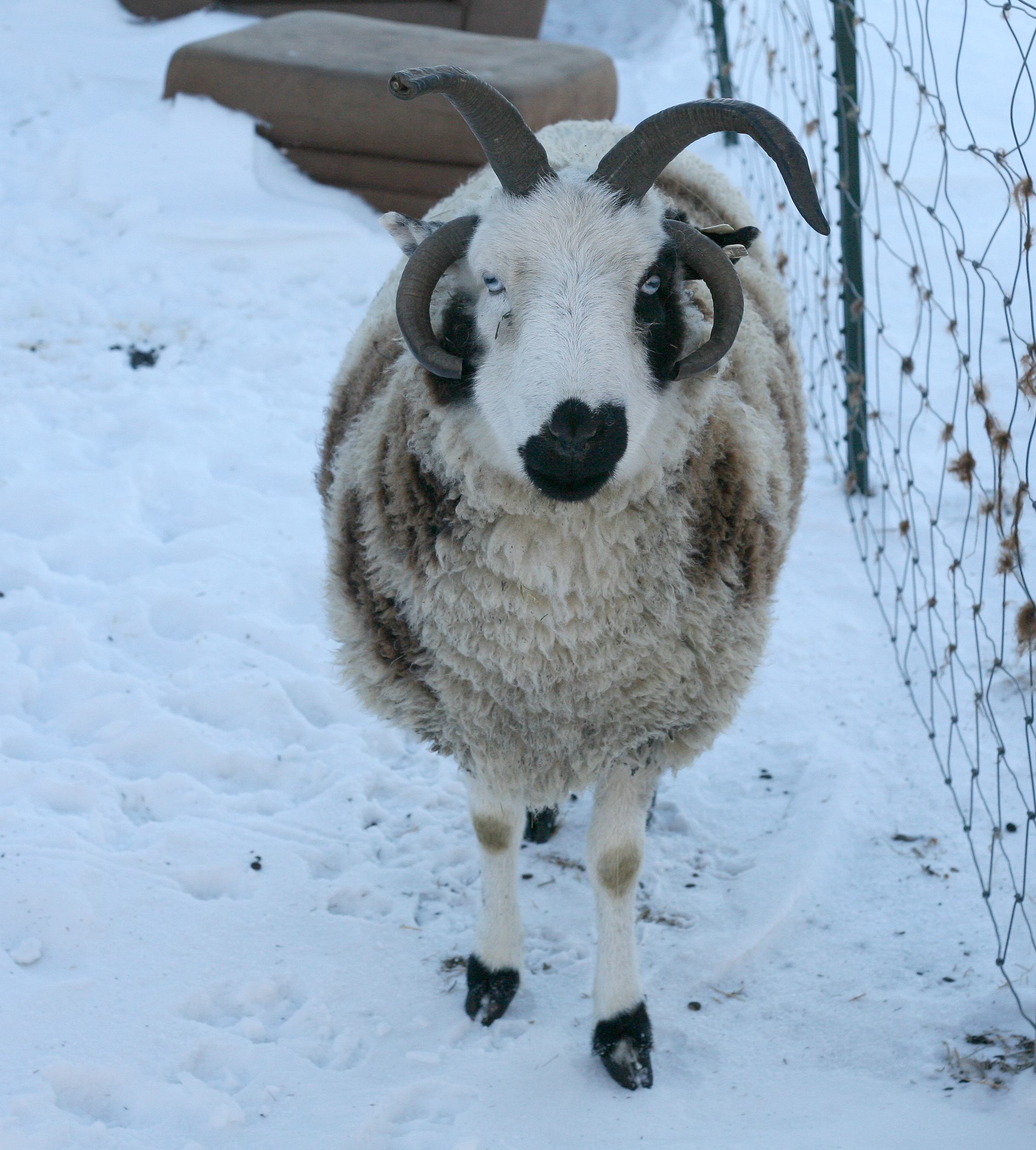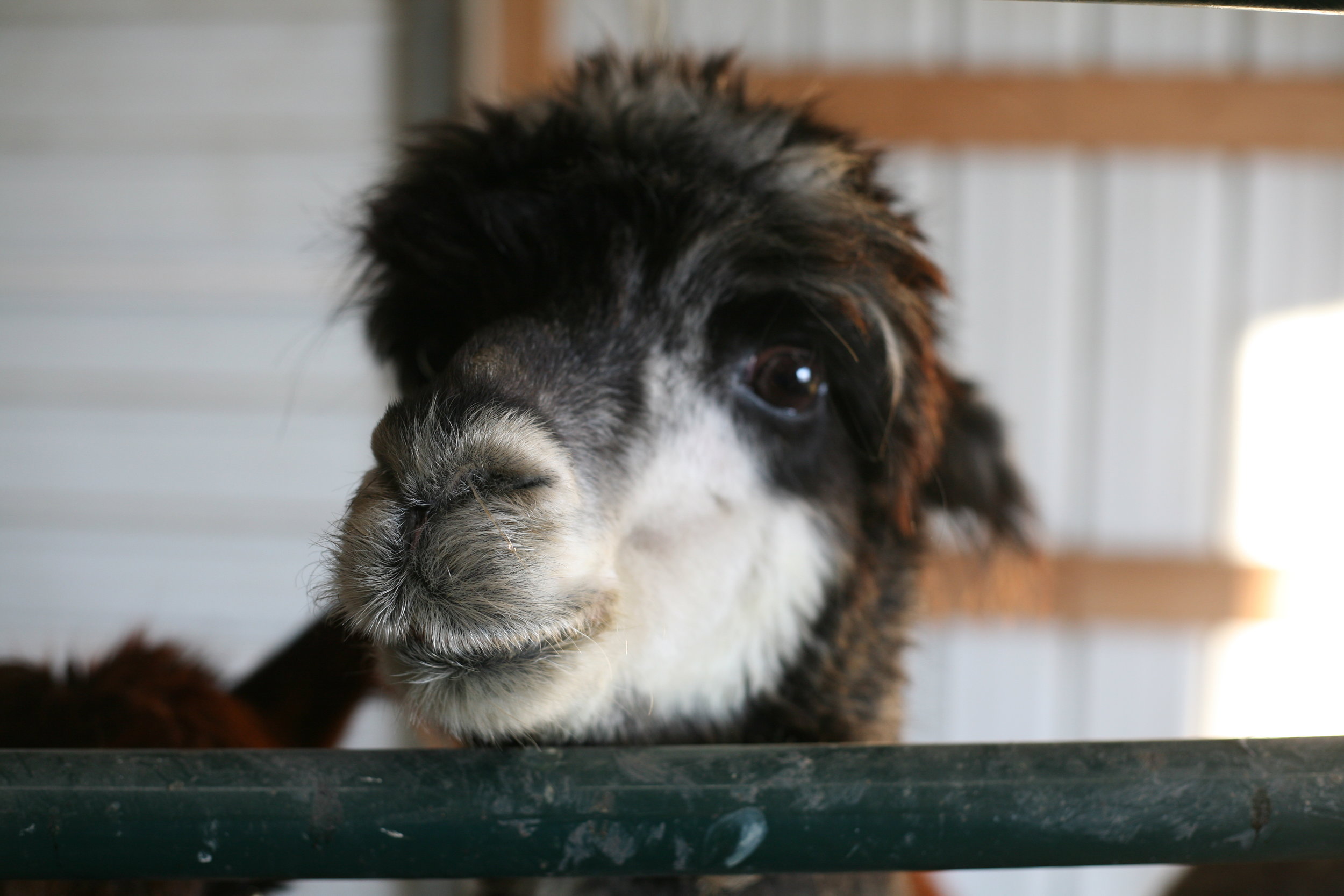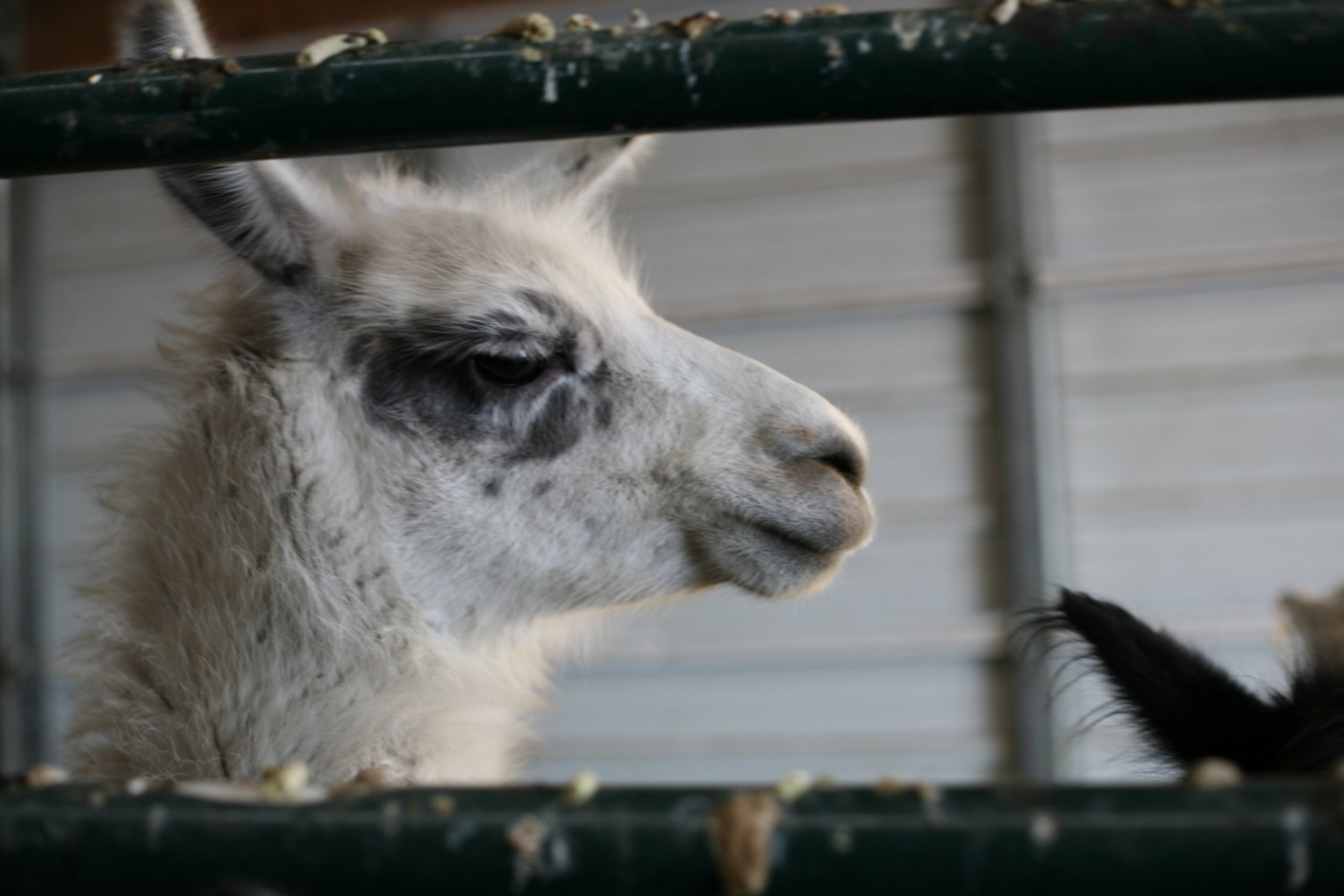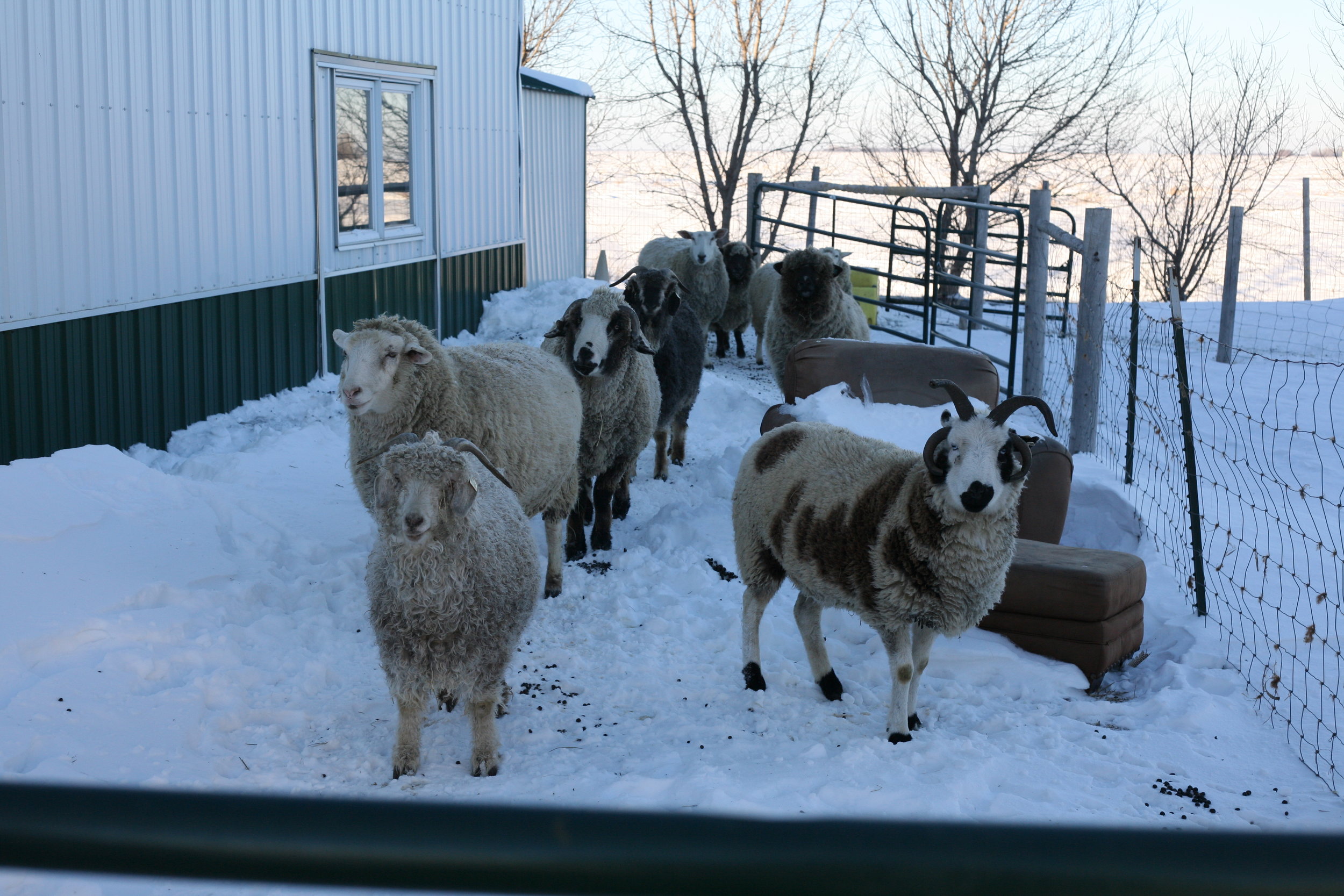Breeding Season Part 1: LLAMAS - A Post by Luke
I've said it before but I'll say it again: Llamas are weird.
And horny teenage llamas? Flat out ridiculous.
We got our boy llama, Leo, earlier this summer, and he was perfect. Healthy, easy going (for llamas this means not totally insane), and very protective of the herd.
Then I guess his hormones kicked in and all he wanted to do was get with the sheep.
Luckily the sheep were way faster than him. And Leo has the coordination of a baby giraffe tumbling around a cement mixer, so they weren't in too much danger. But still...that's some messed up stuff going on out there. And I had to watch it everyday as I was trying to eat my breakfast.
Our options were either get him snipped or find him a girlfriend. Getting him castrated would cost like 250 bucks, and female llamas were going for around 300.
So why put him through an operation when for a few extra bucks we could get him some company? And then...baby llamas, right? Win/win.
Anna found a female llama for sale nearby. We brought her home and our boys named her Donnie, short for Donatella. Because we're still letting our kids name the animals, and they're really into Ninja Turtles. (It was that or Michaelanga or Raphaela. So Donnie it is).
Donnie in her new home!
Donnie's a beaut. An all black female, fully mature. Raised on a farm of only female llamas. So an amazon llama of sorts. Leo would be her first encounter with a male of her species.
He made a horrible first impression.
When she arrived he was chasing the sheep around the tall grass like a deranged Muppet. It wasn't going well for him, and also he looked terrible doing it.
With that going on in the background we showed Donnie around her new place.
Now, this is the fourth llama we've brought to the property and she was by far the most docile. She causally checked out the feeder, the shelter, and the fences. Occasionally she paused to nibble apple slices from our hands. A real lady.
Then Leo noticed her.
He was panting, out of breath from another failed attempt at hybridization. But when he looked over at her he just froze.
You could actually see cartoon hearts pop out his eyeballs as he stood there blinking his long goofy white eyelashes in disbelief.
Then he strutted over to Donnie and started making this weird mating call, which can only be described as “pathetically horny.”
Think Beavis and Butthead chuckling, mix in a little Seth Rogen, release helium, and you've got the mating call of the adolescent llama. It's bonkers.
The courtship....
He started making that noise, then never stopped. It just became ambiance.
I'd walk out to the shop and I'd hear llamas mating. I'd go check for eggs and I'd hear llamas mating. I'd be working on the house and I'd hear llamas mating.
Those llamas did it 24/7 for about two and half months.
Then one day I saw Donnie do something I'd never seen a llama do before. She spit at him.
Now I understand they're camelids and this is what they do, but none of our llamas had ever spit before. Plus I was surprised by the sheer force of it.
Leo tried going for it again and she just spun her neck around like a cobra and gave him three sharp blasts to the face. He got the message and backed off.
Back at the house I told Anna what just happened.
“I think Donnie's pregnant.” I said.
“Why do you say that?” she asked.
“She's done messing around.”
“Maybe she's just tired of him.”
“Maybe she is. But I'm going to mark it on the calendar anyway.”
And that was that. For a while.
Then our sheep went into heat again and Leo went back to being his old cross-breeding self.
So we called the vet. He said he'd make a house call to come fix our llama.
“What do you need?” I asked over the phone.
“Oh, you know, we should be good,” he said. “...if you've got an extension cord that will reach, that would be nice. A bucket of warm water, maybe a couple of bales of hay. That should do it.”
So with those basics of farm surgery lined up, we got right too it.
I pinned Leo to the side of the shelter and we gave him a shot of tranquilizer. (By the way, this is my main job on the farm – animal tackler. I take great pride in it. Lately I've been able to do some sweet, mid-air takeouts of even our flightiest sheep. They used to elude me, but not anymore. Now I'm inside their heads. Game over, ungulates.)
Hug-restraining a 200 pound llama as it starts going unconscious is a pretty goofy experience. Within moments you switch from grappling a frightened animal to snuggling a couch sized teddy bear.
Finally Leo went completely slack and we rested him on the bedding of the shelter. The vet propped up Leo's hind quarters and got to work.
Anna was holding his tail and I was cradling his head so he wouldn't choke while under. I couldn't really see what was going on.
“Do you really want to?” Anna asked.
“Well, kind of. Yeah.”
“We could switch. You could hold his tail.”
I didn't tell her at the time, but I had this fear of him violently ejecting feces while unconscious, so I declined. Besides, if I craned my neck a bit I could see everything the vet was doing.
This wasn't our first time sterilizing animals. Last spring Anna and I elastrated three lambs. (Elastration is when you snap a band around an animals testes. Then after sufficient time/blood loss its balls “painlessly” fall off. That's what the propaganda states, anyway.)
I hated elastrating. Watching those little dudes trying to shake off a rubber band they couldn't get to was awful. I was wincing and walking funny after each procedure.
But this time it was all surgical. Poke, slit, clamp, tie, snip - done.
Afterward, Anna had to snuggle with Leo to keep his head up while he came around from the drugs. I brought her a coffee and she spent about an hour cradling four feet of groggy llama neck. It was the most one-on-one time she's had with our llama since he arrived here. It was good for farm morale.
A little one-on-one time with Leo in Post-op!
So there you go. We picked up another llama but in the end still had to get our guy castrated.
But that's classic farm planning for you: chose the option you think is best, only to end up having to pay for the other thing anyway once your first plan fails.
Anyway, if Donnie is preggers we should be seeing a baby llama sometime around August 2018. Llamas mate constantly and then gestate for 11 months.
Sheep, on the other hand, need only a few seconds of togetherness and then gestate for 5 months.
They're up next.
Muddy the Ram curling his lip ready for mating (the flehmen response)
Dakota Spinning Mill - A post by Anna
A few weeks ago we took a little road trip to Fargo, North Dakota to pick up our first batch of homegrown yarn! The boys were super excited, as road trips always mean pizza on the bed, hotel pools and ice machines! This kind of road-trip was equally as exciting for me because - well YARN!
I had to search quite a while for a place to process my fibre, there are no mills in Manitoba or Saskatchewan, and shipping fees to other Provinces can be quite exorbitant. Thankfully, I was able to send the fleece down south in the summer and a few months later I recieved the call that it was ready! We arrived at the Dakota Fiber Mill and were greeted by Chris, owner of the mill and one of the greatest fibre folk I have ever met, and her 7+ foot tall camel - staring out at us around the barn!
I have never seen a camel this close, and we were all awe-struck. He was so gentle, and quiet, and it seemed as though his big huge eyes were all knowing. I seriously think Luke is trolling kijiji and local livestock pages for listings of camels. Chris brushes this guy once a year, and she said it takes about a week to fully brush him. She then spins his fibre with a blend of wool and/or alpaca. I bought of skein of this yarn and it's beautiful!
Chris has a mixed flock and herd of other fibre animals including alpacas, angora goats, jacob sheep, cotswald, and angora bunnies! All her animals are friendly and you can tell they are well taken care of and produce beautiful fibre.
Chris gave us a tour of her wool mill and also the small retail shop attached. It was such an informative, lovely tour, and helped me understand wool processing on a new level. Chris answered all of our questions, and indulged the boys as they asked her all about every little thing in the mill - mostly the parrot that lives in the mill and totally captivated my boys!
yarn on the spinner
I cannot take credit for the quality of this yarn - as the fleece was grown while the sheep still lived at their first home - the farm of my good friends and shepherdess mentors Margaret and Linda. But having this first batch of fleeces spun into yarn is giving me a good idea of what to expect with my growing little flock. We have sent some of this yarn to the Kickstarter recipients that supported our fundraiser last year, and the rest of it will become available for sale in Spring 2017.
fleece drying after being washed
As a long-time knitter and owner of a local yarn store for 6 years, I had never before visited a spinning mill. I found the tour and experience invaluable to really connecting me to what is involved in the process of 'sheep to shawl' I strongly urge any of you that have not had this experience to find a local wool mill and go for a tour.
And for those of you who are in Manitoba and Saskatchewan and wish that you had a mill to visit, hang tight, because I am planning to open a wool mill! I wasn't going to say anything on the blog until it was officially going to happen. But I think I would love the feedback, comments, suggestions, and encouragement from all of you, as it's a huge undertaking and I need all the moral support I can get!
Long Way Yarn!
We are hoping that the mill will be open late 2017/early 2018, but we are still in some early planning stages. I believe that this is such a crucial step in creating a sustainable, local and environmentally sustainable industry. So much of the fleece from Manitoba sheep farmers is shipped to other parts of the world where it is cleaned/carded/manufactured and then shipped back to canada as yarn, insulation, rugs and textiles. How amazing would it be to change that produce our own yarn in our own community!
I will share more details with all of you that are following along in the next few months, but in the meantime thanks for your excitement and support of this journey! I'll leave you with one more camel picture - because CAMEL!
-
December 2025
- Dec 5, 2025 Staggering Statistics Dec 5, 2025
-
November 2025
- Nov 23, 2025 Annual Holiday Market Nov 23, 2025
-
August 2025
- Aug 6, 2025 Why is there vegetable matter in my yarn - Carbonization and your wool Aug 6, 2025
- Aug 6, 2025 Folk Fest 2025 Aug 6, 2025
-
July 2025
- Jul 22, 2025 We are Hiring - Wool Mill Operator Jul 22, 2025
- Jul 6, 2025 Fibre & Farm Market - Saturday, July 26 Jul 6, 2025
-
May 2025
- May 14, 2025 10 Year Anniversary - Long Way Homestead in Manitoba May 14, 2025
- May 13, 2025 Book Launch - True Cost of Wool May 13, 2025
- May 1, 2025 Celebrate our 10 year Anniversary May 1, 2025
-
April 2025
- Apr 13, 2025 Upcoming Teaching and Speaking Events - Find a date near you! Apr 13, 2025
-
February 2025
- Feb 3, 2025 A note about Canadian Wool and the new USA Tarrifs Feb 3, 2025
-
January 2025
- Jan 25, 2025 Traceability & Transparency Jan 25, 2025
-
December 2024
- Dec 2, 2024 Big Bluestem Yarn Dec 2, 2024
-
October 2024
- Oct 16, 2024 2025 Calendar is here! Oct 16, 2024
- Oct 1, 2024 NEW Book - True Cost of Wool Oct 1, 2024
-
September 2024
- Sep 25, 2024 Fibre & Farm Fall Market - Saturday, Oct 5, 2024 Sep 25, 2024
- Sep 22, 2024 Top 10 Take-Aways from Sheep & Wool Camp - by Jane Westheuser Sep 22, 2024
-
June 2024
- Jun 7, 2024 Why Natural Dye Jun 7, 2024
-
April 2024
- Apr 26, 2024 Shearing Day Lunch - Recipe Apr 26, 2024
- Apr 12, 2024 Wool Bedding and Sleep Science Apr 12, 2024
-
January 2024
- Jan 19, 2024 Lectures and Presentation on Canadian Sheep and Wool Jan 19, 2024
- Jan 10, 2024 New Sheep - Welcome to our Registered Flock Jan 10, 2024
-
November 2023
- Nov 11, 2023 Merry Maker Market Nov 11, 2023
- Nov 5, 2023 Fibre & Farm Holiday Market Nov 5, 2023
- Nov 1, 2023 Holiday Gift Guide 2023 Nov 1, 2023
-
October 2023
- Oct 19, 2023 Pasture Raised Lamb for Sale Oct 19, 2023
- Oct 15, 2023 Celebrating 5 Years - RECAP Oct 15, 2023
- Oct 9, 2023 Grassland Yarn Oct 9, 2023
-
September 2023
- Sep 19, 2023 Wool Mill Celebration & Reflections Sep 19, 2023
-
July 2023
- Jul 31, 2023 5-Year Mill-aversary - come celebrate with us Jul 31, 2023
-
June 2023
- Jun 4, 2023 Fibre & Farm - Sunday, July 16 2023 Jun 4, 2023
-
January 2023
- Jan 1, 2023 Join us for a Farm & Mill Apprenticeship - Summer 2023 Jan 1, 2023
-
December 2022
- Dec 27, 2022 Is the Breed Study Right For You? Dec 27, 2022
- Dec 15, 2022 NEW On-line Breed Study Dec 15, 2022
-
November 2022
- Nov 26, 2022 About Wool Dryer Balls Nov 26, 2022
-
August 2022
- Aug 13, 2022 A Letter to the Federal Ag Minister Aug 13, 2022
-
June 2022
- Jun 10, 2022 Fibre & Farm Market Jun 10, 2022
-
May 2022
- May 15, 2022 Hiring a Fibre Mill Apprentice May 15, 2022
-
April 2022
- Apr 10, 2022 Shearing Festival 2022 Apr 10, 2022
-
February 2022
- Feb 24, 2022 A Little Too Little.... Feb 24, 2022
- Feb 5, 2022 Canadian National Mill Inventory Survey Feb 5, 2022
-
December 2021
- Dec 10, 2021 Canadian Wool Research & Data 2021 Dec 10, 2021
-
August 2021
- Aug 1, 2021 The Effect of Drought on Wool Production Aug 1, 2021
-
July 2021
- Jul 5, 2021 Fibre & Farm Market Jul 5, 2021
-
May 2021
- May 28, 2021 SponsorSHEEP Lambs 2021 May 28, 2021
-
December 2020
- Dec 16, 2020 Canadian Wool/Sheep Producers Survey Dec 16, 2020
-
November 2020
- Nov 10, 2020 Holiday Gift Guide 2020 Nov 10, 2020
- Nov 1, 2020 Traceability in the Canadian Wool Supply Chain Nov 1, 2020
-
August 2020
- Aug 27, 2020 Manitoba Fibre Trail Aug 27, 2020
-
July 2020
- Jul 22, 2020 Flower & Fibre Natural Dye Workshops Jul 22, 2020
- Jul 8, 2020 Farm Demonstration - Growing, Harvesting and Processing Japanese Indigo Jul 8, 2020
-
May 2020
- May 29, 2020 SponsorSHEEP Lambs 2020 May 29, 2020
- May 19, 2020 Building Resilient Fibre Systems in Canada - by Anna Hunter May 19, 2020
-
April 2020
- Apr 14, 2020 Why Breed Specific? Apr 14, 2020
-
February 2020
- Feb 18, 2020 New House Yarn - Polypay Chunky Feb 18, 2020
-
November 2019
- Nov 12, 2019 Gift Guide 2019 Nov 12, 2019
-
June 2019
- Jun 5, 2019 SponsorSHEEP lambs 2019 Jun 5, 2019
-
May 2019
- May 19, 2019 Shearing Festival April 2019 May 19, 2019
-
August 2018
- Aug 5, 2018 Lamb Day 2018 Aug 5, 2018
-
June 2018
- Jun 1, 2018 SponsorSHEEP 2018 - Jun 1, 2018
-
May 2018
- May 27, 2018 Shearing Day 2018 May 27, 2018
-
April 2018
- Apr 6, 2018 Surprise Lambs Apr 6, 2018
-
January 2018
- Jan 30, 2018 Breeding Season Part III: Chickens. (A post by Luke) Jan 30, 2018
-
December 2017
- Dec 24, 2017 Breeding Season Part II: SHEEP - A Post by Luke Dec 24, 2017
- Dec 3, 2017 Breeding Season Part 1: LLAMAS - A Post by Luke Dec 3, 2017
-
September 2017
- Sep 4, 2017 Our Year of Living Shepardly - A Post by Luke Sep 4, 2017
-
June 2017
- Jun 18, 2017 Lamb Day - June 25th Jun 18, 2017
- Jun 11, 2017 Sponsorsheep June 2017 Jun 11, 2017
-
May 2017
- May 30, 2017 REVIEW - SLOW TV: NATIONAL KNITTING NIGHT - a post by Luke May 30, 2017
- May 6, 2017 First Sponsorsheep Drop - May 7 May 6, 2017
-
April 2017
- Apr 2, 2017 Naturally Dyed Eggs Apr 2, 2017
-
February 2017
- Feb 5, 2017 Dakota Spinning Mill - A post by Anna Feb 5, 2017
-
January 2017
- Jan 25, 2017 Training Day Jan 25, 2017
-
December 2016
- Dec 12, 2016 Book Review: Haynes Sheep Manual - A post by Luke Dec 12, 2016
- Dec 4, 2016 Llama Trauma - a post by Luke Dec 4, 2016
-
October 2016
- Oct 30, 2016 Chickens of Destiny - a Post by Luke Oct 30, 2016
- Oct 24, 2016 Pattern Book Review - Flotsam & Jetsam by Ash Alberg Oct 24, 2016
- Oct 17, 2016 Sheep! Oct 17, 2016
- Oct 9, 2016 THE BALLAD OF WHEEZY MCSICKY PANTS - A Post by Luke Oct 9, 2016
-
September 2016
- Sep 26, 2016 Plants vs. Chickens Sep 26, 2016
-
August 2016
- Aug 30, 2016 Mama Llama Drama - a post by Luke Aug 30, 2016
-
July 2016
- Jul 27, 2016 Rooster Soup - Post by Luke Jul 27, 2016
- Jul 23, 2016 A Fence Post Jul 23, 2016
-
June 2016
- Jun 29, 2016 Arrivederci Figaro - A post by Luke Jun 29, 2016
- Jun 11, 2016 Jurassic Marsh - A post by Luke Jun 11, 2016
- Jun 5, 2016 Drive or be Driven Jun 5, 2016
-
May 2016
- May 20, 2016 Picking up Chicks May 20, 2016
- May 13, 2016 I might be crazy May 13, 2016
